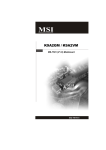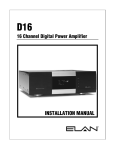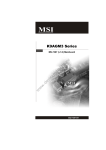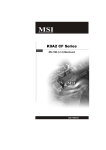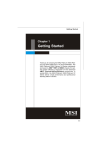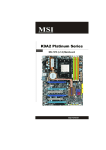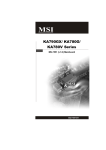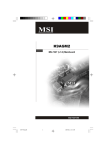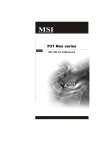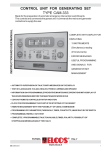Download MSI Media Live User`s manual
Transcript
Media Live DIVA MS-7411 (V1.X) Mainboard G52-74111X2 i Copyright Notice T he material in this doc ument is the intellec tual property of M ICRO-STAR INTERNATIONAL. We take every care in the preparation of this document, but no guarantee is given as to the correctness of its contents. Our products are under continual improvement and we reserve the right to make changes without notice. Trademarks All trademarks are the properties of their respective owners. Intel® and Pentium® are registered trademarks of Intel Corporation. AMD, Athlon™, Athlon™ XP, Thoroughbred™, and Duron™ are registered trademarks of AMD Corporation. NVIDIA, the NVIDIA logo, DualNet, and nForce are registered trademarks or trademarks of NVIDIA Corporation in the United States and/or other countries. PS/2 and OS ® /2 are registered trademarks of International Business Machines Corporation. W indows ® 95/98/2000/NT/XP are registered trademarks of Microsoft Corporation. Netware® is a registered trademark of Novell, Inc. Award® is a registered trademark of Phoenix Technologies Ltd. AMI® is a registered trademark of American Megatrends Inc. Revision History Revision Revision History Date V1.1 First Release November 2008 Technical Support If a problem arises with your system and no solution can be obtained from the user’s manual, please contact your place of purchase or local distributor. Alternatively, please try the following help resources for further guidance. Vis i t the MSI webs ite at http ://glob al.msi. com.tw /index. php? func=service for FAQ, technical guide, BIOS updates, driver updates, and other information. Contact our technical staff at http://ocss.msi.com.tw. ii Safety Instructions 1. Always read the safety instructions carefully. 2. Keep this User’s Manual for future reference. 3. Keep this equipment away from humidity. 4. Lay this equipment on a reliable flat surface before setting it up. 5. The openings on the enclosure are for air convection hence protects the equipment from overheating. DO NOT COVER THE OPENINGS. 6. Make sure the voltage of the power source and adjust properly 110/220V before connecting the equipment to the power inlet. 7. Place the power cord such a way that people can not step on it. Do not place anything over the power cord. 8. Always Unplug the Power Cord before inserting any add-on card or module. 9. All cautions and warnings on the equipment should be noted. 10. Never pour any liquid into the opening that could damage or cause electrical shock. 11. If any of the following situations arises, get the equipment checked by service personnel: The power cord or plug is damaged. Liquid has penetrated into the equipment. The equipment has been exposed to moisture. The equipment does not work well or you can not get it work according to User’s Manual. The equipment has dropped and damaged. The equipment has obvious sign of breakage. 12. DO NOT LEAVE THIS EQUIPMENT IN AN ENVIRONMENT UNCONDITIONED, STORAGE TEMPERATURE ABOVE 600 C (1400F), IT MAY DAMAGE THE EQUIPMENT. CAUTION: Danger of explosion if battery is incorrectly replaced. Replace only with the same or equivalent type recommended by the manufacturer. iii FCC-B Radio Frequency Interference Statement T h is eq uip men t h as been tested and found to c omply with the limits for a Class B digital device, pursuant to Part 15 of the FCC Rules. These limits are designed to provide reasonable protection against harmful interference in a residential installation. This equipment generates, uses and can radiate radio frequency energy and, if not installed and used in accordance with the instructions, may cause harmful interference to radio communications. However, there is no guarantee that interference will not occur in a particular installation. If this equipment does cause harmful interference to radio or television reception, which can be determined by turning the equipment off and on, the user is encouraged to try to correct the interference by one or more of the measures listed below. Reorient or relocate the receiving antenna. Increase the separation between the equipment and receiver. Connect the equipment into an outlet on a circuit different from that to which the receiver is connected. Consult the dealer or an experienced radio/television technician for help. Notice 1 The changes or modifications not expressly approved by the party responsible for compliance could void the user’s authority to operate the equipment. Notice 2 Shielded interface cables and A.C. power cord, if any, must be used in order to comply with the emission limits. VOIR LA NOTICE D’INSTALLATION AVANT DE RACCORDER AU RESEAU. Micro-Star International MS-7411 This device complies with Part 15 of the FCC Rules. Operation is subject to the following two conditions: (1) this device may not cause harmful interference, and (2) this device must accept any interference received, including interference that may cause undesired operation. iv WEEE (Waste Electrical and Electronic Equipment) Statement v vi vii CONTENTS Copyright Notice....................................................................................................ii Trademarks.............................................................................................................ii Revision History.....................................................................................................ii Technical Support..................................................................................................ii Safety Instructions................................................................................................iii FCC-B Radio Frequency Interference Statement............................................iv WEEE (Waste Electrical and Electronic Equipment) Statement........................v Chapter 1 Getting Started.................................................................................1-1 Mainboard Specifications................................................................................1-2 Mainboard Layout...........................................................................................1-4 Packing Checklist............................................................................................1-5 Chapter 2 Hardware Setup...............................................................................2-1 Quick Components Guide...............................................................................2-2 CPU (Central Processing Unit)........................................................................2-3 Memory............................................................................................................2-6 Power Supply.................................................................................................2-8 Back Panel......................................................................................................2-9 Connector........................................................................................................2-10 Jumper.............................................................................................................2-16 Slot..................................................................................................................2-17 Chapter 3 BIOS Setup.........................................................................................3-1 Entering Setup.................................................................................................3-2 The Menu Bar.................................................................................................3-4 Main.................................................................................................................3-5 Advanced........................................................................................................3-6 Boot.................................................................................................................3-18 Security...........................................................................................................3-21 Chipset............................................................................................................3-22 Power..............................................................................................................3-26 Exit...................................................................................................................3-28 Appendix A Realtek ALC888 Audio.................................................................A-1 Installing the Realtek HD Audio Driver.............................................................A-2 Software Configuration..................................................................................A-4 Appendix B SATA RAID.......................................................................................B-1 RAID Configuration.........................................................................................B-2 viii Getting Started Chapter 1 Getting Started Thank you for choosing the Media Live DIVA (MS-7411 V1.X) Micro-ATX mainboard. The Media Live DIVA is based on AMD ® RS780M & SB700 chipsets for optimal system efficiency. Designed to fit the advanced AMD ® PhenomTM , AthlonTM 64/ 64 FX/ 64 X2 and SempronTM processors in the socket AM2/ AM2+ package, the Media Live DIVA delivers a high performance and professional desktop platform solution. 1-1 MS-7411 Mainboard Mainboard Specifications Processor - Supports AMD® Phenom TM, AthlonTM 64/ 64 FX/ 64 X2 and SempronT M processors in the socket AM2/ AM2+ package (TDP Max 95 W ) (For the latest information about CPU, please visit http://global.msi.com.tw/index.php?func=cpuform) FSB - Hyper Transport supports speed up to 1.0 GHz (HT1) - Hyper Transport supports speed up to 2.6 GHz (HT3) Chipset - North Bridge: AMD® RS780M chipset - South Bridge: AMD® SB700 chipset Memory - DDR2 400/ 533/ 667/ 800 SDRAM (240-Pin/ 1.8 V) - 4 DDR2 DIMM slots (8GB Max) (Non-ECC) (For more information on compatible components, please visit http://global.msi.com.tw/index.php?func=testreport) LAN - Supports Gigabit Ethernet Controller for PCI ExpressTM Applications by Realtek® RTL8111C IEEE 1394 - Chip integrated by JMicron® JMB381 - Transfer rate is up to 400 Mb/s Audio - Chip integrated by Realtek® ALC888 - Compliant with Azalia 1.0 spec IDE - 1 IDE port by AMD® SB700 - Supports two IDE devices - Supports Ultra DMA 33/ 66/ 100/ 133 mode - Supports PIO, Bus Master operation mode SATA - 4 SATAII ports by AMD® SB700 - Supports 4 SATA devices - Supports storage and data transfers up to 3 Gb/s RAID - SATA1~4 support RAID 0/ 1/ 10 m ode by AMD® SB700 1-2 Getting Started Connector Back Panel - 1 VGA port - 4 USB ports - 1 HDMI port - 1 IEEE 1394 port - 1 LAN jack - 5 audio RCA-in/ out jacks - 3 com ponent video-out jacks - 2 coaxial S/PDIF-in/ out jacks On-Board Pinheader/ Connector - 1 CD-in connector - 1 serial port connector - 4 USB pinheaders - 1 IEEE 1394 pinheader - 1 front panel audio pinheader - 1 CIR connector Slot - 1 PCI express x16 slot (For VGA card use only) - 1 PCI express x4 slot (For amplifier card use only) - 3 PCI express x1 slots Form Factor - Micro-ATX (24.4 cm X 24.4 cm) Mounting - 8 mounting holes 1-3 MS-7411 Mainboard Mainboard Layout JRCA1 CPU_FAN1 JCOM CIR1 T: VGA1 B: SPDIFOUT SPDIF IN HDMI1 T: I1394 B: USB T: LAN B: USB JRCA2 SUBOUT BATT + SATA4 SATA1 SATA2 DAE3 -SOLT SATA3 AMD SB70 0 PCIE1 6_X1 PCIE1 _X2 DIMM4 PCIE1 _X1 DIMM3 DIMM1 JRCA3 DIMM2 IDE 1 AMD RS780 M SYS_FAN1 AT X 1 JPW 1 CLR_CMOS2 PCIE1 _X3 JAUD1 CD_I N JFP1 J139 4_ 2 JUSB0 JUSB3 JUSB2 JUSB1 PW R_ FAN1 Media Live DIVA (MS-7411 V1.X) Micro-ATX Mainboard 1-4 Getting Started Packing Checklist MSI Mainboard MSI Driver/ Utility CD User’s Guide Back I/O Shield Power Cable SATA Cable Amplifier Card Speaker Connector Standard Cable for IDE Devices * The pictures are for reference only and your packing contents may vary depending on the model you purchased. 1-5 Hardware Setup Chapter 2 Hardware Setup This chapter provides you with the information about hardware setup procedures. While doing the installation, be careful in holding the components and follow the installation procedures. For some components, if you install in the wrong orientation, the components will not work properly. Use a grounded wrist strap before handling computer c om ponen ts . S tatic elec tric ity m ay damage the components. 2-1 MS-7411 Mainboard Quick Components Guide CPU_FAN1, CPU, p.2-12 p.2-3 CIR1, p.2-14 Memory, p.2-6 JCOM, p.2-12 Back Panel, p.2-9 ATX1, p.2-8 JPW1, p.2-8 SYS_FAN1, p.2-12 IDE1, p.2-10 SATA1~4, p.2-11 Slot, p.2-17 CLR_CMOS2, p.2-16 JAUD1, CD_IN, p.2-13 p.2-13 2-2 J1394_2, p.2-15 JUSB0~3, PWR_FAN1, JFP1, p.2-12 p.2-15 p.2-14 Hardware Setup CPU (Central Processing Unit) The mainboard supports AMD ® PhenomTM, AthlonTM 64/ 64 FX/ 64 X2 and SempronTM processors in the socket AM2/ AM2+ package. The socket AM2/ AM2+ offers easy CPU installation. When you are installing the CPU, make sure the CPU has a heat sink and a cooling fan attached on the top to prevent overheating. If you do not have the heat sink and cooling fan, contact your dealer to purchase and install them before turning on the computer. For the latest information about CPU, please visit http://global.msi.com.tw/index. php?func=cpuform Important Overheating Overheating will seriously damage the CPU and system. Always make sure the cooling fan can work properly to protect the CPU from overheating. Make sure that you apply an even layer of thermal paste (or thermal tape) between the CPU and the heatsink to enhance heat dissipation. Replacing the CPU While replacing the CPU, always turn off the power supply or unplug the power supply’s power cord from the grounded outlet first to ensure the safety of CPU. Overclocking This mainboard is designed to support overclocking. However, please make sure your components are able to tolerate such abnormal setting, while doing overclocking. Any attempt to operate beyond product specifications is not recommended. We do not guarantee the damages or risks caused by inadequate operation or beyond product specifications. 2-3 MS-7411 Mainboard CPU Installation Procedures for Socket AM2/ AM2+ 1. Please turn off the power and unplug the power cord before installing the CPU. Open the lever Sliding the plate 2. Pull the lever sideways away from the socket. Make sure that you raise the lever up to a 90degree angle. 3. Look for the gold arrow on the CPU. The gold arrow should point as shown in the picture. The CPU c a n on l y f i t i n t h e c or r e c t orientation. Lower the CPU down onto the socket. 4. If the CPU is correctly installed, the pins should be completely embedded into the socket and can not be seen. Please note that any violation of the correct installation procedures may cause permanent damage to your mainboard. 5. Press the CPU down firmly into the socket and close the lever. As the CPU is likely to move while the lever is being closed, always close the lever with your fingers pressing tightly on top of the CPU to make sure the CPU is properly and completely embedded into the socket. 2-4 90 degree Gold arrow Correct CPU placement Gold arrow O Incorrect CPU placement Gold arrow Press down the CPU Close the lever Hardware Setup Installing CPU Cooler Set When you are installing the CPU, make sure the CPU has a heat sink and a cooling fan attached on the top to prevent overheating. If you do not have the heat sink and cooling fan, contact your dealer to purchase and install them before turning on the computer. Important 1. Read the CPU status in BIOS (Chapter 3). 2. Mainboard photos shown in this section are for demonstration of the CPU/ cooler installation only. The appearance of your mainboard may vary depending on the model you purchase. 1. Position the cooling set onto the retention mechanism. Hook one end of the clip to hook first. 2. Then press down the other end of the clip to fasten the cooling set on the top of the retention mechanism. Locate the Fix Lever and lift up it. Fixed Lever 3. Fasten down the lever. 4. Attach the CPU Fan cable to the C P U f a n c on n ec t or on t h e mainboard. 2-5 MS-7411 Mainboard Memory These DIMM slots are intended for memory modules. For more information on compatible components, please visit http://global.msi.com. tw/index.php?func=testreport DDR2 240-pin, 1.8V 56x2=112 pin 64x2=128 pin Dual-Channel Memory Population Rules In Dual-Channel mode, the memory modules can transmit and receive data with two data bus lines simultaneously. Enabling Dual-Channel mode can enhance the system performance. Please refer to the following illustrations for population rules under Dual-Channel mode. DIMM1 DIMM2 DIMM3 DIMM4 DIMM1 DIMM2 DIMM3 DIMM4 DIMM1 DIMM2 DIMM3 DIMM4 Installed Empty 2-6 Hardware Setup Installing Memory Modules 1. The memory module has only one notch on the center and will only fit in the right orientation. 2. Insert the memory module vertically into the DIMM slot. Then push it in until the golden finger on the memory module is deeply inserted in the DIMM slot. The plastic clip at each side of the DIMM slot will automatically close when the memory module is properly seated. Important You can barely see the golden finger if the memory module is properly inserted in the DIMM slot. 3. Manually check if the memory module has been locked in place by the DIMM slot clips at the sides. Volt Notch Important 1. In Dual-Channel mode, make sure that you install memory modules of the same type and density in different channel DIMM slots. 2. To enable successful system boot-up, always insert the memory modules into the DIMM1 first. 3. Due to the chipset resource deployment, the system density will only be detected up to 7+GB (not full 8GB) when each DIMM is installed with a 2GB memory module. 2-7 MS-7411 Mainboard Power Supply ATX 24-Pin Power Connector: ATX1 This connector allows you to connect an ATX 24-pin power supply. To connect the ATX 24-pin power supply, make sure the plug of the power supply is inserted in the proper orientation and the pins are aligned. Then push down the power supply firmly into the connector. You may use the 20-pin ATX power supply as you like. If you’d like to use the 20-pin ATX power supply, please plug your power supply along with pin 1 & pin 13 (refer to the image at the right hand). There is also a foolproof design on pin 11, 12, 23 & 24 to avoid wrong installation. Pin Definition ATX1 12 1 24 13 PIN SIGNAL PIN SIGNAL 1 2 +3.3V +3.3V 13 14 +3.3V -12V 3 4 GND +5V 15 16 GND PS-ON# 5 6 GND +5V 17 18 GND GND 7 8 GND PWR OK 19 20 GND Res 9 10 5VSB +12V 21 22 +5V +5V 11 +12V 12 +3.3V 23 24 +5V GND pin 13 ATX 12V Power Connector: JPW1 This power connector is usaed to provide power to the CPU. Pin Definition JPW1 2 1 PIN SIGNAL 4 3 1 GND 2 3 GND 12V 4 12V Important 1. Make sure that all the connectors are connected to proper power supplies to ensure stable operation of the mainboard. 2. Power supply of 350 watts (and above) is highly recommended for system stability. 2-8 pin 12 Hardware Setup Back Panel 1. 3. 2. Component Video-Out (RGB) 3 RCA jacks. (interlaced or progressive scan) (supports 720p, 1080i HDTV) Red colour: Pr Green colour: Y Blue colour: Pb (not all modes support DVD playback due to content protection ) 1. Front channels Red colour: Line-out (R) W hite colour: Line-out (L) Audio RCA-In/ Out 2. Subwoofer channel Purple colour: Subwoofer-out 3. Red colour: Line-in (R) W hite colour: Line-in (L) VGA-Out Digital Video / Audio-Out USB 2.0 LAN (RJ45) IEEE 1394 Digital Audio-Out 15-pin D-sub HDMI (High Definition Multimedia Interface Support) (supports 720p, 1080i, 1080p HDTV) Four 4-pin USB 2.0 ports (High Speed) Ethernet 10/ 100/ 100/ 1000 6-pin DV input/ output for Digital Video or other device Black colour: Coaxial S/PDIF Output Orange colour: Coaxial S/PDIF Input 2-9 MS-7411 Mainboard Connector IDE Connector: IDE1 This connector supports IDE hard disk drives, optical disk drives and other IDE devices. IDE1 Important If you install two IDE devices on the same cable, you must configure the drives separately to master/ slave mode by setting jumpers. Refer to IDE device’s documentation supplied by the vendors for jumper setting instructions. 2-10 Hardware Setup Serial ATA Connector: SATA1, SATA2, SATA3, SATA4 This connector is a high-speed Serial ATA interface port. Each connector can connect to one Serial ATA device. SATA3 SATA4 SATA2 SATA1 Important Please do not fold the Serial ATA cable into 90-degree angle. Otherwise, data loss may occur during transmission. 2-11 MS-7411 Mainboard Serial Port Connector: JCOM This connector is a 16550A high speed communications port that sends/receives 16 bytes FIFOs. You can attach a serial device to it. Pin Definition 5 6 1 2 JCOM PIN SIGNAL 1 2 SOUTA GROUND 3 4 Key (no pin) GROUND 5 6 SINA VCC5 Fan Power Connector: CPU_FAN1, SYS_FAN1, PWR_FAN1 The fan power connectors support system cooling fan with +12V. W hen connecting the wire to the connectors, always note that the red wire is the positive and should be connected to the +12V; the black wire is Ground and should be connected to GND. If the mainboard has a System Hardware Monitor chipset onboard, you must use a specially designed fan with speed sensor to take advantage of the CPU fan control. CONTROL SENSOR +1 2V GND CPU_FAN1 PWR_FAN1 GND +12V SENSOR Control SYS_FAN1 Important 1. Please refer to the recommended CPU fans at processor’s official website or consult the vendors for proper CPU cooling fan. 2. CPU_FAN1 supports fan control. You can activate the Smart Fan function in the BIOS Setup Utility to automatically control the CPU fan speed according to the actual CPU temperature. 3. Fan/ heatsink with 3 or 4 pins are both available for CPU_FAN1. 2-12 Hardware Setup CD-In Connector: CD_IN This connector is provided for exaternal audio input. GND L R CD_IN Front Panel Audio Connector: JAUD1 This connector allows you to connect the front panel audio and is compliant with Intel® Front Panel I/O Connectivity Design Guide. 10 9 2 1 JAUD1 Pin Definition PIN SIGNAL DESCRIPTION 1 2 MIC_L GND Microphone - Left channel Ground 3 4 MIC_R PRESENCE# Microphone - Right channel Active low signal-signals BIOS that a High Definition Audio dongle is connected to the analog header. PRESENCE# = 0 when a High Definition Audio dongle is connected 5 6 LINE out_R MIC_JD Analog Port - Right channel Jack detection return from front panel microphone JACK1 7 Front_JD Jack detection sense line from the High Definition Audio CODEC jack detection resistor network 8 9 NC LINE out_L No control Analog Port - Left channel 10 LINEout_JD Jack detection return from front panel JACK2 2-13 MS-7411 Mainboard Front USB Connector: JUSB0, JUSB1, JUSB2, JUSB3 This connector, compliant with Intel® I/O Connectivity Design Guide, is ideal for connecting high-speed USB interface peripherals such as USB HDD, digital cameras, MP3 players, printers, modems and the like. Pin Definition 2 1 10 9 JUSB0/ 1/ 2/ 3 PIN SIGNAL PIN SIGNAL 1 VCC 2 VCC 3 USB0- 4 USB1- 5 USB0+ 6 USB1+ 7 GND 8 GND 9 Key (no pin) 10 USB 2.0 Bracket (Optional) Important Note that the pins of VCC and GND must be connected correctly to avoid possible damage. CIR Connector: CIR1 This connector allows you to connect to consumer infrared devices. Pin Definition 1 5 CIR1 2-14 Pin Signal 1 CIRTX 2 3 GND CIRRX 4 5 NC VCC5 Hardware Setup Front Panel Connector: JFP1 This connector is provided for electrical connection to the front panel switches/LEDs and is compliant with Intel® Front Panel I/O Connectivity Design Guide. Pin Definition Power Power LED Switch + - JFP1 2 1 10 9 + - - + HDD Reset LED Switch PIN SIGNAL DESCRIPTION 1 2 HD_LED + FP PWR/SLP Hard disk LED pull-up MSG LED pull-up 3 4 HD_LED FP PWR/SLP Hard disk active LED MSG LED pull-up 5 6 RST_SW PWR_SW + Reset Switch low reference pull-down to GND Power Switch high reference pull-up 7 8 RST_SW + PWR_SW - Reset Switch high reference pull-up Power Switch low reference pull-down to GND 9 RSVD_DNU Reserved. Do not use. IEEE1394 Connector: J1394_2 This connector allows you to connect the IEEE1394 device via an optional IEEE1394 bracket. Pin Definition 10 9 2 1 J1394_2 PIN SIGNAL PIN SIGNAL 1 TPA+ 2 TPA- 3 Ground 4 Ground 5 TPB+ 6 TPB- 7 Cable power 8 Cable power 9 Key (no pin) 10 Ground IEEE1394 Bracket (Optional) 2-15 MS-7411 Mainboard Jumper Clear CMOS Jumper: CLR_CMOS2 There is a CMOS RAM onboard that has a power supply from an external battery to keep the dasta of system configuration. W ith the CMOS RAM, the system can automatically boot OS every time it is turned on. If you want to clear the system configuration, set the jumper to clear data. 1 CLR_CMOS2 1 3 Keep Data 1 3 Clear Data Important You can clear CMOS by shorting 2-3 pin while the system is off. Then return to 1-2 pin position. Avoid clearing the CMOS while the system is on; it will damage the mainboard. 2-16 Hardware Setup Slot PCI (Peripheral Component Interconnect) Express Slot The The The The PCI PCI PCI PCI Express Express Express Express slot supports the PCI Express interface expansion card. x16 slot supports up to 4.0 GB/s transfer rate. x4 slot supports up to 1.0 GB/s transfer rate. x1 slot supports up to 250 MB/s transfer rate. PCI Express x16 Slot (For x8 VGA card use only) PCI Express x4 Slot (For D2AUDIO DAE-3 amplifier card use only) PCI Express x1 Slot speaker connector * We s uggest that you should connect the speaker connector to the amplifier card first for easy and quick installation. Important When adding or removing expansion cards, make sure that you unplug the power supply first. Meanwhile, read the documentation for the expansion card to configure any necessary hardware or software settings for the expansion card, such as jumpers, switches or BIOS configuration. 2-17 BIOS Setup Chapter 3 BIOS Setup This chapter provides you with the information about the BIOS setup program and allows you to configure the system for optimum use. You may need to run the setup program when: An error message appears on the screen during the system booting up and requests you to run SETUP. You want to change the default settings for customized features. 3-1 MS-7411 Mainboard Entering Setup Power on the computer and the system will start POST (Power On Self Test) process. W hen the message below appears on the screen, press <DEL> key to enter Setup. Press DEL to enter SETUP If the message disappears before you respond and you still wish to enter Setup, restart the system by turning it OFF and On or pressing the RESET button. You may also restart the system by simultaneously pressing <Ctrl>, <Alt> and <Delete> keys. Important 1. The items under each BIOS category described in this chapter are under continuous update for better system performance. Therefore, the description may be slightly different from the latest BIOS and should be held for reference only. 2. Upon boot-up, the 1st line appearing after the memory count is the BIOS version. It is usually in the format: A7411AMS V1.0 071508 where: 1st digit refers to BIOS maker as A = AMI, W = AWARD and P = PHOENIX. 2nd - 5th digit refers to the model number. 6th digit refers to the chipset as I = INTEL, A = AMD, N = NVIDIA and V = VIA. 7th - 8th digit refers to the customer as MS = all standard customers. V1.0 refers to the BIOS version. 071508 refers to the date this BIOS was released. 3-2 BIOS Setup Control Keys <-> Move to the previous item <¯> Move to the next item <¬ > Move to the item in the left hand <® > Move to the item in the right hand <Enter> Select the item <Esc> Jumps to the exit menu or returns to the main menu from a submenu <+/PU> Increase the numeric value or make changes <-/PD> Decrease the numeric value or make changes <F1> General help <F10> Save all the CMOS changes and exit Getting Help After entering the Setup menu, the first menu you will see is the Main Menu. M ain M enu The main menu lists the setup functions you can make changes to. You can use the arrow keys (-¯) to select the item. The on-line description of the highlighted setup function is displayed at the bottom of the screen. Sub-M enu If you find a right pointer symbol (as shown in the right view) appears to the left of certain fields that means a sub-menu can be launched from this field. A sub-menu contains additional options for a field parameter. You can use arrow keys (-¯) to highlight the field and press <Enter> to call up the sub-menu. Then you can use the control keys to enter values and move from field to field within a sub-menu. If you want to return to the main menu, just press the <Esc>. General Help <F1> The BIOS setup program provides a General Help screen. You can call up this screen from any menu by simply pressing <F1>. The Help screen lists the appropriate keys to use and the possible selections for the highlighted item. Press <Esc> to exit the Help screen. 3-3 MS-7411 Mainboard The Menu Bar Main Use this menu for basic system configurations, such as time, date etc. Advanced Use this menu to set up the items of special enhanced features available on your system. Boot Use this menu to specify the priority of boot devices. Security Use this menu to set Supervisor and User Passwords. Chipset Use this menu to change the values in the chipset registers and optimize your system’s performance. Power Use this menu to specify your settings for power management. Exit This menu allows you to load the BIOS default values or factory default settings into the BIOS and exit the BIOS setup utility with or without changes. 3-4 BIOS Setup Main BIOS Information This item shows the information of AMI® BIOS. (Read-only) Processor This item shows the information of Processor. (Read-only) System M emory This item shows the information of System Memory. (Read-only) System Time This allows you to set the system time that you want (usually the current time). The time format is <hour> <minute> <second>. System Date This allows you to set the system date that you want (usually the current date). The date format is <day> <month> <date> <year>. [Day] Day of the week, from Sun to Sat, determined by BIOS. [Month] The month from Jan. through Dec. [Date] The date from 1 to 31 can be keyed by numeric function keys. [Year] The year can be adjusted by users. 3-5 MS-7411 Mainboard Advanced WARNING: Setting wrong values in below sections may cause system to malfunction. CPU Configuration Press <Enter> and the following sub-menu appears: 3-6 BIOS Setup M odule Version This item shows the version of the current USB module. (Read-only) AGESA Version This item shows the version of the AMD ® Generic Encapsulated Software Architecture. (Read-only) Physical/ Logical Count These items show the detail CPU information. (Read-only) AM D AthlonTM 64 X2 Dual Core Processor 4400+ Revision This item shows the current status of the processor. (Read-only) Cache L1/ 2/ 3 Cache memory is additional memory that is much faster than conventional DRAM (system memory). W hen the CPU requests data, the system transfers the requested data from the main DRAM into cache memory, for even faster access by the CPU. This item shows the internal cache (also known as L1 or level 1 cache) and external cache (also known as L2 or level 2 cache). Speed This item shows the current CPU Front Side Bus (FSB) clock speed. (Readonly) 3-7 MS-7411 Mainboard NB Clk This item allows you to select the NB clock. Current/ Maximum FSB M ultiplier These items show the current/ maximum FSB Multiplier. (Read-only) GART Error Reporting The GART is a device that translates a range of physical address space, called the GART aperture, to a logical address based on page tables in system memory. This item is used to Enable or Disable GART Error Reporting. M icrocode Update This item is used to Enable or Disable Update CPU Microcode. Secure Virtual M achine M ode This item is used to enable or disable the SVM (Secure Virtual Machine) mode. Pow e r No w This item allows you to enable or disable AMD ® PowerNow technology. W hen set to Enabled, the system always operates in a conserve power mode. If you want optimize the processor, set this item to Disabled, so that the processor’s speed will vary depending on the use of your operating system and applications. Default setting is set to Enabled. 3-8 BIOS Setup IDE Configuration Press <Enter> and the following sub-menu appears: OnBoard PCI IDE Controller The integrated peripheral controller contains a PCI IDE interface with support for two IDE channels. Select [Disabled] to disable the integrated IDE controller, [Primary] to enable only the primary IDE controller, [Secondary] to enable only the secondary IDE controller, or [Both] to enable both IDE controllers. Primary/ Secondary/ Third/ Fourth IDE M aster/ Slave Press <Enter> and the following sub-menu appears: Type Press PgUp/ <+> or PgDn/ <-> to select [Manual], [None] or [Auto] type. Note that the specifications of your drive must match with the drive table. The hard disk will not work properly if you enter improper information for this category. If your hard disk drive type is not matched or listed, you can use [Manual] to define your own drive type manually. 3-9 MS-7411 Mainboard LBA/ Large M ode This item allows you to enable or disable the LBA (Logical Block Address, the logical block size in hard disk) mode. Block (M ulti-Sector Transfer) W hen the setting is Auto, it will read or write more sector at every circle to enhance the hard disk performance. Setting options: [Auto], [Disabled]. PIO M ode The PIO (Programmed Input/ Output) Mode let you set a PIO mode (0-4) for the IDE devices that the onboard IDE interface supports. Modes 0 through 4 provide successively increased performance. In Auto mode, the system automatically determines the best mode for each device. The settings are: [Auto], [Mode 0], [Mode 1], [Mode 2], [Mode 3], [Mode 4]. DM A M ode This item allows you to enable or disable the DMA (Direct Memory Access) mode. S.M.A.R.T This allows you to activate the S.M.A.R.T. (Self-Monitoring Analysis & Reporting Technology) capability for the hard disks. S.M.A.R.T is a utility that monitors your disk status to predict hard disk failure. This gives you an opportunity to move data from a hard disk that is going to fail to a safe place before the hard disk becomes offline. 32Bit Data Transfer The IDE interface in the integrated peripherals controller supports 32bit data transfers. Select [Enabled] only if your IDE hard drives can also support 32-bit transfer mode. 3-10 BIOS Setup SuperIO Configuration Press <Enter> and the following sub-menu appears: Serial Port1 Address This item specifies the base I/O port address of the onboard Serial Port 1 (COM A). Select [Auto] allows AMI® BIOS to automatically determine the correct base I/O port address. Setting options: [3F8/ IRQ4], [2F8/ IRQ3], [3E8/ IRQ4], [2E8/ IRQ3] and [Disabled]. Serial Port1 M ode This item allows you to specify the operation mode for serial port1. Setting options: [Normal], [IrDA], [ASKIR]. [Normal] RS-232C Serial Port [IrDA] IrDA-compliant Serial Infrared Port [ASKIR] Amplitude Shift Keyed Infrared Port OnBoard CIR Port This item is used to Enable or Disable OnBoard Consumer Remote Control (TV remote IR). Chassis Intrusion The field enables or disables the feature of recording the chassis intrusion status and issuing a warning message if the chassis is once opened. To clear the warning message, set the field to [Reset]. The setting of the field will automatically return to [Enabled] later. 3-11 MS-7411 Mainboard Hardware Health Configuration Press <Enter> and the following sub-menu appears: H/W Health Function This setting enables Hardware Health Monitoring Device. CPU/ System/ Power FAN Mode Setting This item allows you to specify the operation mode for CPU/ System/ Power FAN. Setting options: [Full On mode], [Automatic mode], [PWM Manually mode]. [Full On mode] Fan work on full speed. [Automatic mode] The PW M value is subject to the temperature inputs linear changs. [PWM Manually mode] The PW M value is subject to the value set by user. CPU Temperature, System Temperature1/ 2, CPU/ System/ Power Fan Speed These items display the current status of all of the monitored hardware devices and components such as CPU temperature and system fan speed. +3.30V, +5.00V, VCC, +12.0V, CPU Core These items display the current status of all of the monitored hardware devices and components such as CPU voltages. 3-12 BIOS Setup ACPI Configuration Press <Enter> and the following sub-menu appears: General ACPI Configuration Press <Enter> and the following sub-menu appears: Suspend mode Select the type of Suspend mode: [Auto] After the period of inactivity selected in the Auto Suspend Timeout field, the system automatically enters STD mode. If STD mode is unavailable, the system enters STR mode. [S1] Save to disk [S3] Suspend to RAM Report Video on S3 Resume This item is used to Enable or Disable Report Video on S3 Resume. Advanced ACPI Configuration Press <Enter> and the following sub-menu appears: 3-13 MS-7411 Mainboard ACPI Version Features This item is used to select the ACPI Features. ACPI APIC support This item is used to Enable or Disable support ACPI APIC. AMI OEMB table This item is used to Enable or Disable AMI® OEM ACPI table. Headless mode This feature allows operating without a keyboard, monitor or mouse. To run in headless mode, both BIOS and operating system must support headless operation. W hen enabled, the BIOS will update the FACP to indicate support for headless operation. Operating systems that support headless operation can proceed to boot in headless mode. 3-14 BIOS Setup Event Log Configuration Press <Enter> and the following sub-menu appears: View Event Log This item is used to view the Event Log which occurred during post or runtime. M ark all events as read This item is used to mark all events as read and they do not display at next time. Clear Event Log This item is used to clear all events in nvram and they do not display at next time. 3-15 MS-7411 Mainboard USB Configuration Press <Enter> and the following sub-menu appears: M odule Version - 2.24.3-13.4 USB Devices Enabled: 1 Keyboard, 1 Drive Legacy USB Support Set to [Enabled] if your need to use any USB 1.1/ 2.0 device in the operating system that does not support or have any USB 1.1/ 2.0 driver installed, such as DOS and SCO Unix. Set to [Disabled] only if you want to use any USB device other than the USB mouse. USB 2.0 Controller Mode Set to [Enabled] if you need to use any USB 2.0 device in the operating system that does not support or have any USB 2.0 driver installed, such as DOS and SCO Unix. BIOS EHCI Hand-Off This is a workaround for OSes without EHCI hand-off support. The EHCI ownership change should claim by EHCI driver. USB Mass Storage Device Configuration Press <Enter> and the following sub-menu appears: 3-16 BIOS Setup USB Mass Storage Reset Delay This option specifies amount of time the BIOS should wait after issuing a reset to the USB mass storage devices. Device #1 Lenovo USB Flash Drive PMAP Emulation Type This field allows you to enable or disable the USB Port 64/60 Emulation function. W hen the function is enabled, the USB keyboard is allowed to type some special combination keys. 3-17 MS-7411 Mainboard Boot Boot Settings Configuration Press <Enter> and the following sub-menu appears: Quick Boot Setting the item to [Enabled] allows the system to boot within 5 seconds since it will skip some check items. Quiet Boot If set to [enabled] the OS boots straight to the GUI without showing the POST screen, if set to [disabled] it boots to the POST first. 3-18 BIOS Setup Bootup Num-Lock This setting is to set the Num Lock status when the system is powered on. Setting to [On] will turn on the Num Lock key when the system is powered on. Setting to [Off] will allow users to use the arrow keys on the numeric keypad. Wait For ‘F1’ If Error This BIOS feature controls the system's response when an error is detected during the boot sequence. W hen enabled, the BIOS will halt the boot sequence when an error is detected. You will need to press the F1 button at this point. It brings you to the BIOS setup menu where you can adjust the settings to fix the problem. W hen disabled, the BIOS will not halt the boot sequence, even when an error is detected. The system will continue to boot into the operating system. Boot Device Priority Press <Enter> and the following sub-menu appears: 1st/ 2nd Boot Device These items allow you to set the s equence of boot devices where BIOS attempts to load the operating system. Hard Disk Drives Press <Enter> and the following sub-menu appears: 1st Drive This item allows you to set the type of hard disk drives installed. 3-19 MS-7411 Mainboard Removable Drives Press <Enter> and the following sub-menu appears: 1st Drive This item allows you to set the type of removable drives installed. 3-20 BIOS Setup Security Supervisor Password User Password : Not Installed : Not Installed Change Superv isor Password Use this item to change the supervisor password that controls access to the BIOS Setup utility. Change User Password Use this item to change the user password that controls access to the system at boot. Boot Sector Virus Protection W hen you enable this item and someone attempt to write data into this area, BIOS will show a warning message on screen and it will alarm beep. 3-21 MS-7411 Mainboard Chipset NorthBridge Configuration Press <Enter> and the following sub-menu appears: Internal Graphics Configuration Press <Enter> and the following sub-menu appears: 3-22 BIOS Setup Internal Graphics M ode The field allows you to select whether the UMA (Unified Memory Architecture) or Sideport (Local Frame Buffer) memory allocated for video memory. UMA Frame Buffer Size Frame Buffer is the video memory that stores data for video display (frame). This field is used to determine the memory size for Frame Buffer. Larger frame buffer size increases video performance. SIDEPORT Clock Speed This item is used to adjust the Side Port Memory Clock. GFX Engine Clock Override This item is used to adjust the GFX Engine Clock Clock. Primary Video Controller This item used to select the Primary Video Controller interface. AMD 780 HD Audio This item used to Enable or Disable the AMD ® 780M(NB) HD Audio. 3-23 MS-7411 Mainboard SouthBridge Configuration Press <Enter> and the following sub-menu appears: HD Audio Azalia Device This item is used to Enable or Disable the AMD SB700(SB) HD Audio. OnChip SATA Channel/ Type This setting is used to specify the SATA controller. The settings are: [Disabled] Disable the SATA controller. [Auto] PATA and SATA will be arranged by BIOS, and you will be able to see the IDE Device status listed in Standard COMS Features. [Legacy Mode] PATA and SATA will be combined. Max. of 2 IDE drives in each channel are available. [Native IDE] PATA and SATA will both be enabled. Max. of 6 IDE drives are supported. SATA IDE Combined Mode This item is used to Enable or Disable the SATA IDE Combined Mode. PATA Channel Config This item is used to select the PATA Channel. 3-24 BIOS Setup OnBoard Peripherals Configuration Press <Enter> and the following sub-menu appears: Realtek 8111C PCIE NIC This item is used to Enable or Disable OnBoard LAN (Realtek® 8111C) Device. Realtek 8111C Option ROM This item is used to Enable or Disable OnBoard LAN (Realtek® 8111C) Option ROM. Onboard 1394 Controller This setting is used to Enable or Disable the onboard IEEE 1394 controller. 3-25 MS-7411 Mainboard Power Power M anagement/ APM Setting to [Enabled] will activate an Advanced Power Management (APM) device to enhance Max Saving mode and stop CPU internal clock. Power Button M ode This feature allows users to configure the Power Button function. Settings are: [Off] The power button functions as a normal power-on/-off button. [Suspend] W hen you press the power button, the computer enters the suspend/ sleep mode, but if the button is pressed for more than four seconds, the computer is turned off. Resume on PME W hen setting to [Enabled], this setting allows your system to be awakened from the power saving modes through any event on PME (Power Management Event). RTC Resume W hen [Enabled], your can set the date and time at which the RTC (real-time clock) alarm awakens the system from Suspend mode. 3-26 BIOS Setup Restore on AC Power Loss This setting specifies whether your system will reboot after a power failure or interrupt occurs. Available settings are: [Off] Leaves the computer in the power off state. [On] Leaves the computer in the power on state. [Last State] Restores the system to the previous status before power failure or interrupt occurred. 3-27 MS-7411 Mainboard Exit Save Changes and Exit Save changes to CMOS and exit setup. Discard Changes and Exit Abandon all changes and exit setup. Discard Changes Abandon all changes. Load Optimal Defaults Use this menu to load the default values set by the mainboard manufacturer specifically for optimal performance of the mainboard. Load Failsafe Defaults Us e this menu to load the def ault values set by the BIOS vendor for stable systemperformance. 3-28 Appendix A Realtek ALC888 Audio The Realtek ALC888 provides 10-channel DAC that simultaneously supports 7.1 sound playback and 2 channels of independent s tereo s ound output (multiple streaming) through the Front-Out-Left and Front-OutRight channels. MS-7411 Mainboard Installing the Realtek HD Audio Driver You need to install the driver for Realtek ALC888 codec to function properly before you can get access to 2-, 4-, 6-, 8- channel or 7.1+2 channel audio operations. Follow the procedures described below to install the drivers for different operating systems. Installation for Windows 2000/ XP/ Vista For W indows ® 2000, you must install W indows ® 2000 Service Pack4 or later before installing the driver. For Windows ® XP, you must install W indows ® XP Service Pack1 or later before installing the driver. The following illustrations are based on W indows ® XP environment and could look slightly different if you install the drivers in different operating systems. 1. Insert the application CD into the CD-ROM drive. The setup screen will automatically appear. 2. Click Realtek HD Audio Driver. Click here Important The HD Audio Configuration software utility is under continuous update to enhance audio applications. Hence, the program screens shown here in this section may be slightly different from the latest software utility and shall be held for reference only. A-2 Realtek ALC888 Audio 3. Click Next to install the Realtek High Definition Audio Driver. Click here 4. Click Finish to restart the system. S el ec t t hi s option Click here A-3 MS-7411 Mainboard Software Configuration After installing the audio driver, you are able to use the 2-, 4-, 6- or 8- channel audio feature now. Click the audio icon from the system tray at the lower-right corner of the screen to activate the HD Audio Configuration. It is also available to enable the audio driver by clicking the Realtek HD Audio M anager from the Control Panel. Double click A-4 Realtek ALC888 Audio Sound Effect Here you can select a sound effect you like from the Environment list. Environment Simulation You will be able to enjoy different sound experience by pulling down the arrow, totally 23 kinds of sound effect will be shown for selection. Realtek HD Audio Sound Manager also provides five popular settings “Stone Corridor”, “Bathroom”, “Sewer pipe”, “Arena” and “Audio Corridor” for quick enjoyment. You may choose the provided sound effects, and the equalizer will adjust automatically. If you like, you may also load an equalizer setting or make an new equalizer setting to save as an new one by using the “Load EQ Setting” and “Save Preset” button, click “Reset EQ Setting” button to use the default value, or click “Delete EQ Setting” button to remove a preset EQ setting. There are also other pre-set equalizer models for you to choose by clicking “Others” under the Equalizer part. A-5 MS-7411 Mainboard Equalizer Selection Equalizer frees users from default settings; users may create their owned preferred settings by utilizing this tool. 10 bands of equalizer, ranging from 100Hz to 16KHz. Save The settings are saved permanently for future use Reset 10 bands of equalizer would go back to the default setting Enable / Disable To disable, you can temporarily s top the sound effect without losing the settings Lo ad W henever you would like to use preload settings, simply click this, the whole list will be shown for your selection. Delete To delete the pre-saved settings which are created from previous steps. A-6 Realtek ALC888 Audio Frequently Used Equalizer Setting Realtek recognizes the needs that you might have. By leveraging our long experience at audio field, Realtek HD Audio Sound Manager provides you certain optimized equalizer settings that are frequently used for your quick enjoyment. [How to Use It] Other than the buttons “Pop” “Live” “Club” & “Rock” shown on the page, to pull down the arrow in “Others”, you will find more optimized settings available to you. Karaoke M ode Karaoke mode brings Karaoke fun back home. Simply using the music you usually play, Karaoke mode can help you eliminate the vocal of the song or adjust the key to accommodate your range. 1.Vocal Cancellation: Single click on “Voice Cancellation”, the vocal of the song would be eliminated, while the background music is still in place, and you can be that singer! 2.Key Adjustment: Using “Up / Down Arrow” to find a key which better fits your vocal range. Raise the key Remov e the human voice Lower the key A-7 MS-7411 Mainboard Mixer In the Mixer part, you may adjust the volumes of the rear and front panels individually. 1. Adjust Volume You can adjust the volume of the speakers that you pluged in front or rear panel by select the Realtek HD Audio rear output or Realtek HD Audio front output items. Important Before set up, please make sure the playback devices are well plugged in the jacks on the rear or front panel. The Realtek HD Audio front output item will appear after you pluging the speakers into the jacks on the front panel. 2. Multi-Stream Function ALC888 supports an outstanding feature called Multi-Stream, which means you may play different audio sources simultaneously and let them output respectively from the indicated real panel or front panel. This feature is very helpful when 2 people are using the same computer together for different purposes. Click the button and the Mixer ToolBox menu will appear. Then check the Enable playback multi-streaming and click OK to save the setup. Important If you use AC97 front panel, the device have to be plugged into the jacks on the panel before enable the multi-stream function. A-8 Realtek ALC888 Audio W hen you are playing the first audio source (for example: use W indows Media Player to play DVD/VCD), the output will be played from the rear panel, which is the default setting. Then you must to select the Realtek HD Audio front output from the scroll list first, and use a different program to play the second audio source (for example: use Winamp to play MP3 files). You will find that the second audio source (MP3 music) will come out from the Line-Out audio jack of Front Panel. A-9 MS-7411 Mainboard 3. Playback control Playback device Tool Mute This function is to let you freely decide which ports to output the sound. And this is essential when multistreaming playback enabled. - Realtek HD Audio Rear Output - Realtek HD Audio Front Output M u te You may choose to mute single or multiple volume controls or to completely mute sound output. Tool - Show the following volume controls This is to let you freely decide which volume control items to be displayed. - Advanced controls - Enable playback multi-streaming W ith this function, you will be able to have an audio chat with your friends via headphone (stream 1 from front panel) while still have music (stream 2 from back panel) in play. At any given period, you can have maximum 2 streams operating simultaneously. A-10 Realtek ALC888 Audio 4. Recording control Tool Mute Recording device -Back Line in/Mic, Front Lin in -Realtek HD Audio Input M u te You may choose to mute single or multiple volume controls or to completely mute sound input. Tool - Show the following volume controls This is to let you freely decide which volume control items to be displayed. - Enable recording multi-streaming Important ALC888 allows you to record the CD, Line, Mic and Stereo Mix channels simultaneously, frees you from mixing efforts. At any given period, you may choose 1 of the following 4 channels to record. A-11 MS-7411 Mainboard Audio I/O In this tab, you can easily configure your multi-channel audio function and speakers. You can choose a desired multi-channel operation here. a. Headphone for the common headphone b. 2CH Speaker for Stereo-Speaker Output c. 4CH Speaker for 4-Speaker Output d. 6CH Speaker for 5.1-Speaker Output e. 8CH Speaker for 7.1-Speaker Output Speaker Configuration: 1. Plug the speakers in the corresponding jack. 2. Dialogue “connected device” will pop up for your selection. Please select the device you have plugged in. - If the device is being plugged into the correct jack, you will be able to find the icon beside the jack changed to the one that is same as your device. - If not correct, Realtek HD Audio Manager will guide you to plug the device into the correct jack. A-12 Realtek ALC888 Audio Connector Settings Click to access connector settings. Disable front panel jack detection (option) Find no function on front panel jacks? Please check if front jacks on your system are so-called AC’97 jacks. If so, please check this item to disable front panel jack detection. M ute rear panel output when front headphone plugged in. Enable auto popup dialogue, when device has been plugged in Once this item checked, the dialog “Connected device” would automatically pop up when device plugged in. A-13 MS-7411 Mainboard S/PDIF Short for Sony/Philips Digital Interface, a standard audio file transfer format. S/PDIF allows the transfer of digital audio signals from one device to another without having to be converted first to an analog format. Maintaining the viability of a digital signal prevents the quality of the signal from degrading when it is converted to analog. Output Sampling Rate 44.1KHz: This is recommend while playing CD. 48KHz: This is recommended while playing DVD or Dolby. 96KHz: This is recommended while playing DVD-Audio. 192KHz: This is recommended while playing High quality Audio. Output Source Output digital audio source: The digital audio format (such as .wav, .mp3,.midi etc) will come out through S/PDIF-Out. A-14 Realtek ALC888 Audio Test Speakers You can select the speaker by clicking it to test its functionality. The one you select will light up and make testing sound. If any speaker fails to make sound, then check whether the cable is inserted firmly to the connector or replace the bad speakers with good ones. Or you may click the auto test button to test the sounds of each speaker automatically. Center Front Left Front Right Side Right Side Left Rear Left Subwoof er Rear Right A-15 MS-7411 Mainboard Microphone In this tab you may set the function of the microphone. Select the Noise Suppression to remove the possible noise during recording, or select Acoustic Echo Cancelltion to cancel the acoustic echo druing recording. Acoustic Echo Cancelltion prevents playback sound from being recorded by microphone together with your sound. For example, you might have chance to use VOIP function through Internet with your friends. The voice of your friend will come out from speakers (playback). However, the voice of your friend might also be recorded into your microphone then go back to your friend through Internet. In that case, your friend will hear his /her own voic e again. W ith AEC(Ac oustic Echo Cancellation) enabled at your side, your friend can enjoy the benefit with less echo. A-16 Realtek ALC888 Audio 3D Audio Demo In this tab you may adjust your 3D positional audio before playing 3D audio applications like gaming. You may also select different environment to choose the most suitable environment you like. A-17 MS-7411 Mainboard Information In this tab it provides some information about this HD Audio Configuration utility, including Audio Driver Version, DirectX Version, Audio Controller & Audio Codec. You may also select the language of this utility by choosing from the Language list. Also there is a selection Show icon in system tray. Switch it on and an icon will show in the system tray. Right-click on the icon and the Audio Accessories dialogue box will appear which provides several multimedia features for you to take advantage of. A-18 SATA RAID Appendix B SATA RAID The Southbridge integrates SATA host controller that supports four SATA ports and RAID function for performance and reliability. SATA RAID provides support for RAID 0 (Striping), RAID 1 (Mirroring), RAID 0+1 (Striping & Mirroring). RAID 0 greatly improves h ard d is k I/O p erf or manc e by concurrently striping data across multiple drives. RAID 1 makes sure data is not lost if a drive fails as data is simultaneously written to two drives. Drives configured for RAID Striping are said to form a RAID 0 set, while drives configured for RAID Mirroring are said to form a RAID 1 set. RAID 0+1 is implemented as a mirrored array whose segments are RAID 0 arrays. RAID has same fault tolerance as mirroring and reduces overhead by striping. It needs at least four drives to form a RAID. B-1 MS-7411 Mainboard RAID Configuration Creating and deleting RAID set and performing other RAID setting up operations are done in the RAID BIOS. During bootup, a screen similar to the one below will appear for about few seconds. Press <Ctrl-F> to enter the FastBuild utility. Important Be sure to set the SATA Mode to “RAID” in BIOS (the path is : Intergrated Peripherals => On-Chip ATA Devices => OnChip SATA Controller) before configuting the RAID BIOS. The Fast Build Utility menu screen will appear. The Main Menu is used to choose the operation to be performed. B-2 SATA RAID View Drives Assignments This window displays the model number, capacities and assignment of the drives physically attached to the SATA host adapter. B-3 MS-7411 Mainboard Define LD (Creating RAID) The selection of the RAID configuration should be based upon factors including performance, data security, and the number of drives available. It is best to carefully consider the long-term role of the system and plan the data storage strategy. RAID sets can be created either automatically, or to allow the greatest flexibility, manually. 1. Press 2 on the Main Menu screen to enter the Define LD Menu. 2. Press the arrow keys to highlight an logical drive number you want to define and press Enter to select it. and press Enter to select it. 3. On the next screen, use the space key to choose a RAID mode (RAID 0/ 1/ 0+1) and use the arrow key to move to the Drives Assignments window. • Initialize logical drive, zero the disk drives. RAID 1 or 10 only. B-4 SATA RAID • Stripe Block Size, the default 64KB is best for most applications. RAID 0 or 10 only. • Gigabyte Boundary, allows use of slightly smaller replacement drives. • Cache Mode, W riteThru or W riteBack. 4. On the Drives Assignments window, use the arrow key to choose the hard drives which you want to make part of the LD, use the space key to change the assignment to “Y”. Then press [Ctrl+Y] to save the configuration. 5. A message will show up on the bottom, press any key to save the configuration or press [Ctrl-Y] to allocate the RAID capacity manually. Important 1. The default capacity is the full capacity of the selected hard drives. 2. If you allocate the first LD capacity manually, you can create second LD with remaining capacity of the selected hard drives. B-5 MS-7411 Mainboard 6. The LD creation is done, the screen shows the LD information as below. Press ESC key to the main screen. 7. Press ESC key to exit the utility, a message “System is going to REBOOT! Are You Sure?” will display, answer “Y” to exit it and the system will reboot. B-6 SATA RAID Delete LD (Deleting RAID) 1. Select “Delete LD” on the main screen. 2. Choose a LD No you want to delete and press “Del” or “Alt+D” delete the RAID set. 3. On the next screen, a message will display to inform you, press “Ctrl+Y” to delete the RAID set or other key to abort it. Press “Ctrl+Y” to complete the deletion. B-7 MS-7411 Mainboard Installing the RAID Driver (for bootable RAID Array) 1. 2. After you complete the RAID BIOS setup, boot from the W indows CD, and the W indows XP Setup program starts. Press F6 and wait for the W indows Setup screen to appear. Important Please follow the instruction below to make a SATA RAID driver for yourself. 1. Insert the MSI CD into the CD-ROM drive. 2. Click the “Browse CD” on the Setup screen. 3. Copy all the contents in the : for Windows XP driver CD \ATI\ATIDrv\SBDrv\RAID for Windows Vista driver CD \ChipSet\ATI\Packages\Drivers\SBDrv\RAID\x86 and \ChipSet\ATI\Packages\Drivers\SBDrv\RAID\x64 to a formatted floppy disk. 4. The driver disk for RAID controller is done. 3. Insert the floppy that contains the RAID driver,Press the “S” key to select “Specify Additional Device”. 4. For W indows Vista: During the Operating system installation, after selecting the location to install Vista click on “Load Driver” button to install a third party SCSI or RAID driver. 5. W hen prompted, insert the floppy disk or media (Floppy, CD/DVD Or USB) and press Enter. 6. You should be shown a list of available SCSI Adapters. 7. Select “ATI AHCI Compatible RAID Controller -x86 platform” when the system is 32-bit version or “ATI AHCI Compatible RAID Controller -x64 platform” when the system is 64-bit version and then press ENTER. 8. The next screen should confirm that you have selected the ATI RAID controller. Press ENTER again to continue. 9. You have successfully installed the ATI RAID driver, and W indows setup should continue. 10. Leave the disk in the floppy drive until the system reboots itself. W indows setup will need to copy the files from the floppy again after the RAID volume is formatted, and W indows setup starts copying files. B-8 SATA RAID Installing the RAID Driver Under Windows (for Non-bootable RAID Array) 1. Insert the MSI CD into the CD-ROM drive. 2. The CD will auto-run and the setup screen will appear. 3. Under the Driver tab, click on ATI System Driver. The ATI System Driver includes RAID Driver. 4. The driver will be automatically installed. Important You must install the RAID driver to enable RAID. B-9























































































